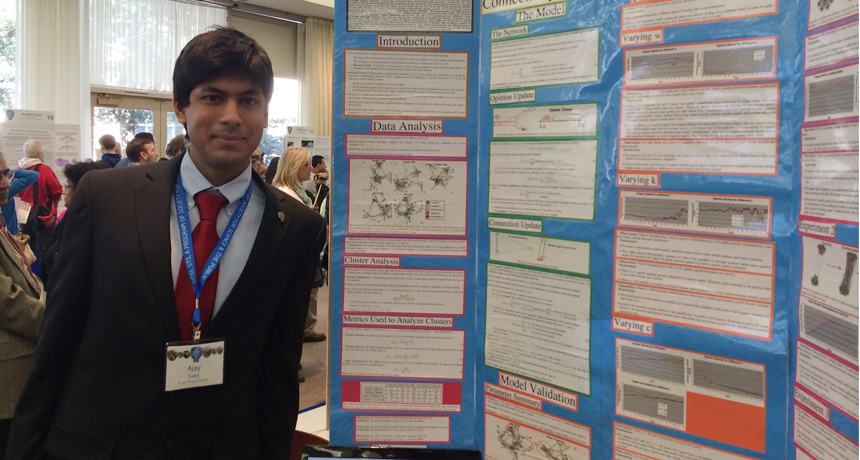Intel STS finalist’s computer program models social life
Ajay Saini is able to predict the spread of opinions and habits among communities

Ajay Saini shows off his research on social networks at the Intel Science Talent Search. He made a computer program that models how habits spread through social groups.
B. Brookshire/SSP
Share this:
- Share via email (Opens in new window) Email
- Click to share on Facebook (Opens in new window) Facebook
- Click to share on X (Opens in new window) X
- Click to share on Pinterest (Opens in new window) Pinterest
- Click to share on Reddit (Opens in new window) Reddit
- Share to Google Classroom (Opens in new window) Google Classroom
- Click to print (Opens in new window) Print
WASHINGTON — Research can teach people much about their world. A scientist might see ecosystems, metals or organs of the body in entirely new ways. For Ajay Saini, 17, research changed how he views groups of people. “It’s made me think about how societies work,” he says. “I see the interconnectedness of everything and how every piece of society relates to every other piece.” The teen used computer science and math to look at social networks. His findings could be used for everything from predicting the spread of the flu to better marketing of the next iPhone.
Ajay, a senior at Acton-Boxborough Regional High School in Acton, Mass., presented his findings at the 2014 Intel Science Talent Search. Run by Society for Science & the Public, the Science Talent Search brings 40 high school seniors to Washington, D.C. They share their research with the public and have a chance to meet their government representatives.
Mention social networks and most people will think of Facebook or Twitter. But Ajay says “a social network is any society in which people can interact with each other and change aspects of themselves based on their interactions.” A group of friends at school is a social network. So is a set of coworkers or a sports team. In each crowd, some people will be close friends and some will be merely acquaintances.
Within a social network, there are habits that everyone might share. They might listen to the same music, use hookahs or drop the same curse words in daily conversation. It turns out that some people are more influential than others in shaping the habits of groups. And those people might be targeted to introduce good habits or make bad habits unpopular. For example, what if all members of a sports team shared the same bad habit of not brushing their teeth. How might you get them to pick up the toothpaste? “You need to figure out which individuals should be targeted,” Ajay explains. That way, “by interacting with others in the group, those individuals will spread good health habits to as many other people as possible.”
Ajay tackled this question using computer science. During a year-long research internship at the Massachusetts Institute of Technology in Cambridge, he looked at social data the school’s Human Dynamics Lab had collected from a group of students living in a dormitory at nearby Harvard. Students formed small closely connected groups — clumps — that are loosely linked to other groups, he found. Ajay then designed a computer program to predict how different habits might spread through these groups.
His program takes into account such things as which people are in which social group, how close they are likely to be and who is most likely to mimic the fashions and actions of another. Targeting certain people in only one group – what people might call opinion leaders – can foster the spread of new habits, his computer program showed.
A new habit exhibited by one member of a small group would be picked up by others in that group. Then, the habit would spread to other, more loosely connected groups. But the new habit would fail to take hold if an entire group had been targeted, not just a few trendsetters.
The results could be important for businesses marketing a new product. With a computer program like this, they might figure out who to target with advertising. Ajay hopes his research can be used to spread new and positive health habits. Examples might include encouraging people to get yearly flu shots. Such a program might also be used to help predict how a disease might spread within a community.
Ajay was pleased to merge his two passions, math and computer science, to learn more about society. “You can model people using this,” he learned. “And that was so exciting!”
Power Words
computer model A program that runs on a computer that creates a model, or simulation, of a real-world phenomenon or event.
ecosystem A group of interacting living organisms — including microorganisms, plants and animals — and their physical environment within a particular climate. Examples include tropical reefs, rainforests, alpine meadows and polar tundra.
hookah A water pipe used to cool smoke — usually tobacco smoke — that will be inhaled. According to the U.S. Centers for Disease Control and Prevention, “hookah smoking carries many of the same health risks as cigarettes.”
internship A training program where students learn advanced professional skills by working alongside experts. People who participate in these training programs are called interns. Some intern in medicine, others in the sciences, journalism or business.
marketing The strategy for getting people to adopt a new policy or buy new products. In many cases, the marketing may rely on advertising or getting celebrities and other trendsetters to endorse a policy or product.
social network Communities of people that are interrelated owing to the way they relate to each other, such as sharing details of their life and interests on Twitter or Facebook, or perhaps belonging to the same sports team, religious group or school.
Editor’s note: This post was updated on March 25, 2014 to correct the length of Ajay’s internship at MIT.







